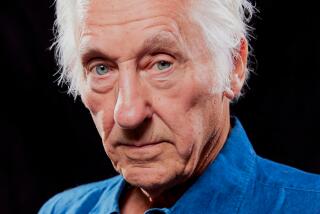Santa Monica
- Share via
Remember Robert Rauschenberg of the ‘50s? The one who introduced “combines” made of old shoes, rusty cast-offs, an entire set of bedding and--in one famous case--a stuffed goat with a tire around its neck?
Since that seminal period of Pop art, we’ve come to know Rauschenberg as a collector of more manageable rubbish and a connoisseur of photographic images that he transfers onto collage-like artworks. His work has become more refined and lyrical, but it hasn’t retained the clout of those brash, early pieces. They gave new life to improbable foundlings as if it were an inevitable development.
Now, in 13 pieces from his ongoing “Glut Series,” the old Rauschenberg is back. Well, all right, it’s impossible to follow the goat act and he doesn’t introduce new wonders of taxidermy. He does, however, fashion raggedly muscular sculptures and wall pieces that put us in mind of his early work. They are made from such treasures as a rusty folding chair, a flattened stovepipe, floral grillwork and loads of sheet metal, variously painted, folded or rumpled.
Rauschenberg harvested these materials near his home on Captiva Island off Florida, but--apart from a couple of street signs--they convey no particular sense of place to the casual viewer. What they do impart is his eye for a consumer society’s excess, along with his sharp sense of design and that talent for transforming junk by changing its context.
“Cathedral Late Summer Glut,” composed of a couple of reels and a curling swath of corrugated metal, is a grand gesture that evokes rolling seas or landscape. “Bullet Glut,” a riveted metal construction focusing on a stop sign that’s been used for target practice, is as distinctly urban as a Stuart Davis painting but it’s tinged with violence. A red canister-like piece, called “Summer Glut Potato,” sits on the floor like an an overfed rodent.
There’s obvious social commentary in a series called “Glut” that’s made from refuse, but Rauschenberg has such a way with detritus that he undercuts that message. You have to wonder if a world without trash would be better than a world without Rauschenberg. (BlumHelman Gallery, 916 Colorado Ave., to Dec. 5.)
More to Read
The biggest entertainment stories
Get our big stories about Hollywood, film, television, music, arts, culture and more right in your inbox as soon as they publish.
You may occasionally receive promotional content from the Los Angeles Times.










